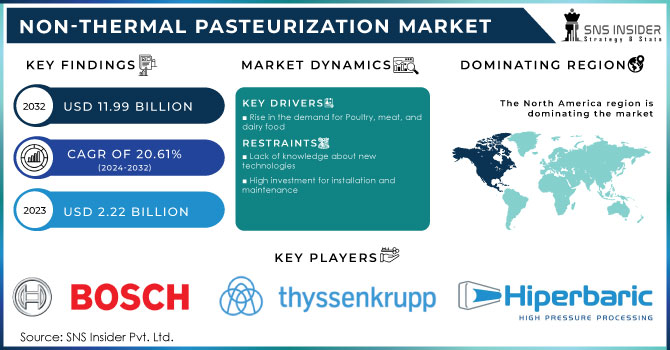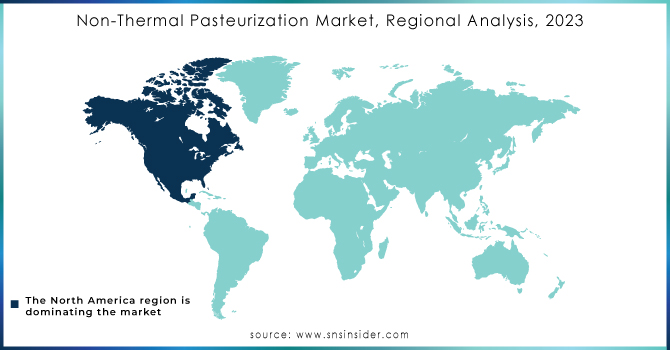Non-Thermal Pasteurization Market Report Scope & Overview:

Get More Information on Non-Thermal Pasteurization Market - Request Sample Report
The Non-Thermal Pasteurization Market size was USD 2.22 billion in 2023 and is expected to Reach USD 11.99 billion by 2032 and grow at a CAGR of 20.61% over the forecast period of 2024-2032.
Non-thermal pasteurization is a food processing technique that uses physical or chemical methods to kill harmful microorganisms in food without the use of heat. the rising need for products with no processing that still have their original flavor, value, and texture. Food producers may satisfy this demand while still maintaining the security of their goods thanks to non-thermal pasteurization. It is commonly known that non-thermal pasteurization techniques including PEF, UV light treatment, and HPP retain food products' original ingredients.
Non-thermal pasteurization has several benefits over conventional thermal pasteurization, including the ability to preserve the nutritional value and sensory qualities of food better than thermal pasteurization, the ability to process a wider range of food products, including foods that are sensitive to heat, and the ability to use less energy.
based on technique the segments of non-thermal pasteurization are Processing food under high pressures (up to 6,000 psi) for a brief amount of time, usually, a few minutes is known as high pressure cooking. Microorganisms are killed when their cell walls are damaged by high pressure. A pulsed electric field exposes food to brief, high-voltage electrical bursts. Microorganisms are killed when their cell membranes are damaged by an electric field. Food is exposed to ultraviolet light during ultraviolet (UV) irradiation, which destroys the DNA of germs and renders them ineffective.
MARKET DYNAMICS
KEY DRIVERS
-
Rise in the demand for Poultry, meat, and dairy food
The growing consumption of ready-to-eat food products, fruits & vegetables, dairy products, and others in developing countries drives the demand for high food production. The growing demand for food products drives the demand for food processing equipment. Poultry, meat, and dairy foods are perishable in nature and are susceptible to spoilage by harmful bacteria. Non-thermal pasteurization can be used to effectively kill these bacteria without affecting the quality of the food. This makes it an ideal method for preserving these foods.
RESTRAIN
-
Lack of knowledge about new technologies
-
High investment for installation and maintenance
Non-thermal pasteurization technology is much more expensive than standard thermal pasteurization equipment. Due to the complexity of the equipment and infrastructure, non-thermal pasteurization technologies such as Pulse Electric Field, High Pressure Processing, Irradiation, Microwave Volumetric Heating, and Ultrasonic necessitate a significant investment. This is because non-thermal pasteurization requires complex and sophisticated technology. Small and medium-sized food manufacturers may find it challenging to employ non-thermal pasteurization equipment due to the significant capital expenditure required. As a result, the high capital cost of non-thermal pasteurization equipment can be a barrier to market growth.
OPPORTUNITY
-
Increased cases of foodborne problems
-
Increased Government support for food processing machinery and equipment
Governments throughout the world are increasingly investing in food processing technology to increase food safety and quality. This investment is assisting in the development of non-thermal pasteurization technology, which is viewed as a more effective and gentle method of food preservation.
Non-thermal pasteurization technologies, such as HPP, PEF, and MVH, are gaining favor among food makers due to their ability to destroy hazardous bacteria while preserving nutritional value and sensory qualities. These procedures are also regarded as less harmful to the environment than standard thermal pasteurization processes, which necessitate the use of high temperatures. Government assistance for food processing gear and equipment is assisting food firms in making non-thermal pasteurization more affordable and accessible. This is resulting in higher adoption of non-thermal pasteurization technology, which is propelling the non-thermal pasteurization market forward.
CHALLENGES
-
Limited technical knowledge of technology
Non-thermal pasteurization methods, in comparison with thermal pasteurization technology, are relatively new and require specialist knowledge to adjust the process parameters for each product. Furthermore, the regulatory environment for non-thermal pasteurization is still emerging, and extra technical requirements for obtaining regulatory approval for these procedures may exist. This is owing to rising demand in the food and beverage industries as businesses become more aware of the advantages of this technology.
IMPACT OF RUSSIAN UKRAINE WAR
The Russia-Ukraine conflict is expected to have a mixed influence on the non-thermal pasteurization market. High-pressure vessels and pulsed electric field generators are two of the main raw materials used in non-thermal pasteurization that are exported from Russia and Ukraine. Supply routes are likely to be broken down by the war, which will result in a shortage of key commodities and higher pricing. Due to consumers' growing concern for the safety of food produced in the area, the demand for safe food is projected to drive the market as a result of the war.
IMPACT OF ONGOING RECESSION
The recession has affected the non-thermal pasteurization market due to a surge in prices of food products people may prefer homecooked food and cut down expenses for pasteurized or processed convenience food. On the one hand, supply chain snags and a rise in the demand for safe food may result in greater costs and a dearth of non-thermal pasteurization techniques. Non-thermal pasteurization technologies may become less popular during a recession because people and manufacturers may be more concerned with saving money.
KEY MARKET SEGMENTS
by Technique
-
PEF
-
HPP
-
MVH
-
Irradiation
-
Ultrasonic
-
Other
by Form
-
Solid
-
Liquid
by Application
-
Food & Beverages
-
Pharmaceuticals
-
Cosmetics
REGIONAL ANALYSIS
North America is predicted to drive market expansion owing to the high criteria for food safety set by the regulatory agencies in nations like Canada, Mexico, and others. The successful enforcement of these food laws makes a substantial contribution to the expansion of the local market. In addition, packaged goods are abundant in regional marketplaces, filling the demand for loose, unbranded goods.
The Asia Pacific region is predicted to develop the fastest throughout the projection period, owing to increased population and disposable income, which are boosting the region's consumer market. The region's non-thermal pasteurization market is influenced by the growing packaged food & beverage, and dairy product consumer market. Governments in the Asia Pacific are supporting the development and adoption of non-thermal pasteurization techniques through funding R&D, providing incentives to food manufacturers, and enacting supportive regulations.
Europe is expected to drive market expansion during the anticipated period due to a surge in the demand for food products that have undergone little processing, Additionally, greater consumer awareness of food safety, stricter legislation governing food safety standards, and technological breakthroughs in non-thermal pasteurization procedures are driving the expansion of the European industry.

Need any customization research on Non-Thermal Pasteurization Market - Enquiry Now
REGIONAL COVERAGE
North America
-
US
-
Canada
-
Mexico
Europe
-
Eastern Europe
-
Poland
-
Romania
-
Hungary
-
Turkey
-
Rest of Eastern Europe
-
-
Western Europe
-
Germany
-
France
-
UK
-
Italy
-
Spain
-
Netherlands
-
Switzerland
-
Austria
-
Rest of Western Europe
-
Asia Pacific
-
China
-
India
-
Japan
-
South Korea
-
Vietnam
-
Singapore
-
Australia
-
Rest of Asia Pacific
Middle East & Africa
-
Middle East
-
UAE
-
Egypt
-
Saudi Arabia
-
Qatar
-
Rest of Middle East
-
-
Africa
-
Nigeria
-
South Africa
-
Rest of Africa
-
Latin America
-
Brazil
-
Argentina
-
Colombia
-
Rest of Latin America
KEY PLAYERS
JBT Corporation, Hiperbaric, Thyssenkrupp AG, Kobelco Construction Machinery Ltd., Bosch, Baotou KeFa High Pressure Technology Co., Ltd, Symbios Technologies, Elea Technology, American Pasteurization Company, Harwood Engineering Company, Inc, and other key players are mentioned in the final report.
RECENT DEVELOPMENTS
In 2023 American Pasteurization Company (APC), a national pioneer in high-pressure processing purchased FreshCo Foods, a Milwaukee-based, end-to-end co-manufacturer of specialty and premium food products. FreshCo has been renamed APC Manufacturing as part of the acquisition.
In 2023 Alpine Wurst, a major manufacturer of high-quality meats, announced intentions to expand its facility by adding a cutting-edge HPP 135L machine from Hiperbaric, an established supplier of HPP technology.
In 2022 Elea Technology Pulsed Electric Fields Technology was a part of FoodPlant, Singapore's first collaborative facility for small-batch food production to assist food manufacturing industry innovation.
| Report Attributes | Details |
| Market Size in 2023 | US$ 2.22 Billion |
| Market Size by 2032 | US$ 11.99 Billion |
| CAGR | CAGR of 20.61 % From 2024 to 2032 |
| Base Year | 2023 |
| Forecast Period | 2024-2032 |
| Historical Data | 2020-2022 |
| Report Scope & Coverage | Market Size, Segments Analysis, Competitive Landscape, Regional Analysis, DROC & SWOT Analysis, Forecast Outlook |
| Key Segments | • By Technique (PEF, HPP, MVH, Irradiation, Ultrasonic, and Others) • By Form (Solid and Liquid) • By Application (Food & Beverages, Pharmaceuticals, and Cosmetics) |
| Regional Analysis/Coverage | North America (US, Canada, Mexico), Europe (Eastern Europe [Poland, Romania, Hungary, Turkey, Rest of Eastern Europe] Western Europe] Germany, France, UK, Italy, Spain, Netherlands, Switzerland, Austria, Rest of Western Europe]), Asia Pacific (China, India, Japan, South Korea, Vietnam, Singapore, Australia, Rest of Asia Pacific), Middle East & Africa (Middle East [UAE, Egypt, Saudi Arabia, Qatar, Rest of Middle East], Africa [Nigeria, South Africa, Rest of Africa], Latin America (Brazil, Argentina, Colombia Rest of Latin America) |
| Company Profiles | JBT Corporation, Hiperbaric, Thyssenkrupp AG, Kobelco Construction Machinery Ltd., Bosch, Baotou KeFa High Pressure Technology Co., Ltd, Symbios Technologies, Elea Technology, American Pasteurization Company, Harwood Engineering Company, Inc |
| Key Drivers | • Rise in the demand for Poultry, meat, and dairy food |
| Market Opportunity | • Increased cases of foodborne problems • Increased Government support for food processing machinery and equipment |

